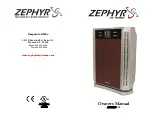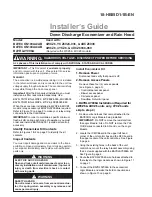
7
Unconditioned Spaces
All ductwork passing through unconditioned space must be
properly insulated to prevent condensation and minimize
duct losses. Use insulation with an outer vapor barrier.
Refer to local codes for insulation material requirements.
Acoustical Ductwork
Certain installations may require acoustical lining inside
the supply ductwork. Acoustical insulation must be in
accordance with the current revision of the Sheet Metal
and Air Conditioning Contractors National Association
(SMACNA) application standard for duct liners. Duct lining
must be U.L. classified batts or blankets with a fire hazard
classification of FHC-25/50 or less.
Fiber ductwork may be used in place of internal duct liners
if the fiber ductwork is in accordance with the current
revision of the SMACNA construction standard on fibrous
glass ducts.
Fibrous ductwork and internal acoustical lining must be
NFPA Class 1 air ducts when tested per U.L. Standard
181 for Class 1 ducts.
Downflow to Horizontal Conversion
The unit is shipped ready for downflow duct connections. If
horizontal ducts are required, the unit must be converted
according to the directions in the conversion kit for both
the supply and return ducts.
ELECTRICAL WIRING
WARNING:
To avoid the risk of electrical shock, personal
injury, or death, disconnect all electrical power
to the unit before performing any maintenance
or service. The unit may have more than one
electrical power supply.
• Electrical connections must be in compliance with
all applicable local codes and ordinances, and with
the current revision of the National Electric Code
(ANSI/NFPA 70).
• For Canadian installations the electrical connections
and grounding shall comply with the current Canadian
Electrical Code (CSA C22.1 and/or local codes).
Pre-Electrical Checklist
√
Verify that the voltage, frequency, and phase of the
supply source match the specifications on the unit
rating plate.
√
Verify that the service provided by the utility is sufficient
to handle the additional load imposed by this equipment.
See Tables 2a-2b (page 19), Table 3 (page 20) or the
unit wiring label for proper high and low voltage wiring.
√
Verify factory wiring is in accordance with the unit wiring
diagram. Inspect for loose connections.
√
For 3 phase units always check the phase balance.
Line Voltage
It is recommended that the line voltage to the unit be
supplied from a dedicated branch circuit containing the
correct fuse or circuit breaker for the unit.
IMPORTANT NOTE:
An electrical disconnect must
be installed readily accessible from and located
within sight of the unit. (See unit data label for proper
incoming field wiring). Any other wiring methods must
be acceptable to authority having jurisdiction.
The power supply for the unit must be in accordance with
the unit wiring diagram, and the unit rating plate. Connect
the line-voltage leads to the corresponding terminals on
the terminal block inside the Element access compartment.
Refer to physical data drawings for compartment location.
Use only copper wire for the line voltage power supply
to this unit. Use proper code agency listed conduit and
connector for connecting the supply wires.
All P6SP model units are shipped factory ready for Single
Circuit Electrical Supply connections. See Table 2 or unit
rating label for proper high voltage wiring requirements.
For Dual Electrical Supply connections see unit rating
plate or heater kit installation instructions for proper high
voltage wiring requirements. Use NORDYNE 3-Pole Dual
Circuit Adaptor (P/N-917468 ) for converting to dual supply
connections.
CAUTION:
Label all wires prior to disconnection when
servicing controls. Wiring errors can cause
improper and dangerous operation. Verify
proper operation after servicing.
Units are shipped from the factory wired for 230 or 460 volt
operation. On 208-230V units being placed into 208 volt
operation, remove the lead from the transformer terminal
marked 240V and connect it to the terminal marked 208V.
Overcurrent protection must be provided at the branch
circuit distribution panel and sized as shown on the unit
rating label and according to the National Electric Code
and applicable local codes.
NOTE:
See the unit rating plate
for maximum circuit ampacity and maximum overcurrent
protection limits.
NOTE:
1-3/8” conduit openings are supplied for high
voltage field wiring entrance. If smaller openings are
required use suitable (field supplied) reducers to meet
specific conduit size requirements.
Unbalanced 3-Phase Supply Voltage
Voltage unbalance occurs when the voltages of all phases
of a 3-phase power supply are no longer equal. This
unbalance reduces motor efficiency and performance.
Some underlying causes of voltage unbalance may include:
Lack of symmetry in transmission lines, large single-phase
loads, and unbalanced or overloaded transformers. A
motor should never be operated when a phase imbalance
in supply is greater than 2%.
Perform the following steps
to determine the percentage of voltage imbalance:








































